
Category: Greatest Hits!
Trondheim Soloists: Vaughan Williams, Fantasia on a Theme of Thomas Tallis, etc.
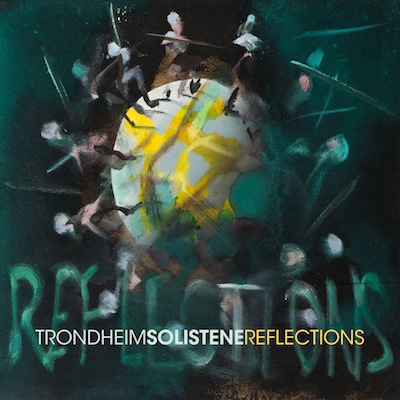
Trondheim Solistene: Reflections
(Music of Britten, Vaughan Williams, and Stravinsky)
SACD/CD +Blu-ray 2-disc set, 2L 125
CDQ; high-resolution stereo including MQA and DSD; and surround-sound downloads available from www.2L.no
Streaming available from various services linked to here.
Recorded June and August 2015, Selbu Church, Norway. Recording producer and balance engineer Morten Lindberg; recording technician Beatrice Johannessen.
Certain pieces of music just catch the ear. Some of those pieces even enter into the collective repository of culture—they become part of the sonic landscape (or the musical memories) of nearly everybody’s life.
A prime candidate for the title of “The Most Well-Known Piece of ‘Classical’ Music That Was Not Composed by Vivaldi, Beethoven, or Gershwin” is Samuel Barber’s Adagio, in its string-orchestra version. Barber’s Adagio for Strings combines striving with yearning (and grief with resignation) in a completely arresting and inescapably memorable way.
Most music lovers don’t realize that the version they know so well is a transcription—that the “Adagio” of movie and pop-culture renown started out life as the slow movement of Barber’s Op. 11 string quartet.
The point of this blog entry then, is to tell as many people as possible that if you love Barber’s Adagio, you will love Ralph Vaughan Williams’ Fantasia on a Theme by Thomas Tallis. The Tallis Fantasia has the same sweeping grandeur and emotional intensity as Barber’s Adagio, but I think it is even more rewarding to engage with over repeated hearings.
More background, a making-of video, and sound bytes, after the jump. Continue Reading →
Morten Lauridsen: “Lux Æterna”
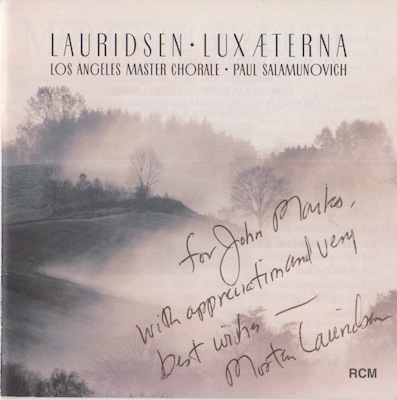
Morten Lauridsen: Lux Æterna and other works
Los Angeles Master Chorale and Sinfonia, Paul Salamunovich, conductor
CD Rubedo Canis Musica RCM 19705
Recorded June 1997 to January 1998, Sacred Heart Chapel, Loyola Marymount University, Los Angeles; Peter Rutenberg, producer; Fred Vogler, engineer.
This recording of Morten Lauridsen’s Lux Æterna was nominated for the Grammy award in its category in 1999. A quick listen to the beginning will tell you why. (A Robert Shaw CD won the award, understandably as it was the year of his death.) Lux Æterna starts with a stroke of genius, and then goes on from strength to strength. The first thing you hear is one of the tallest yet emptiest chords in concert music—the string basses lay down a granite foundation while the high strings harmonize from, it seems, light-years away. And there is nothing in between.
That inspired gesture announces the work as hugely ambitious, while being completely self-assured. Lauridsen is making his personal statement about the meaning of human existence, and nothing less than that. Lux Æterna is one of the masterpieces of the 20th century, and you are really missing out if you have not heard it.
Generous sound samples and more, after the jump. Continue Reading →
“Le Grand Tango”: Music of Astor Piazzolla
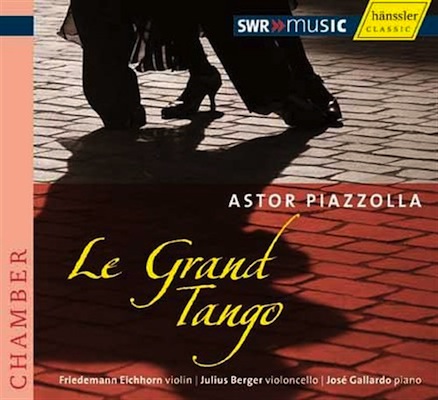
Le Grand Tango: Music of Astor Piazzolla
Recorded March 2005, SWR Funkhaus Mainz
CD SWR KLASSIK 93205
Download (CD Quality Only)
José Gallardo, piano; Friedemann Eichhorn, violin; Julius Berger, cello; José Bragato and Osvaldo Calo, arrangers; Peter Steiber and Sabine Fallerstein, producers; Angela Öztanil, engineer.
Astor Piazzolla (1921-1992) was best known as a performer of his own modernized tango music. His instrument was an unusual concertina (button accordion) called the Bandoneón. The Bandoneón was originally designed (in Germany) as an inexpensive substitute for a church organ, providing chordal accompaniment to congregational hymn singing. That intended use dictated the inner logic of its workings. So the Bandoneon plays different notes from the same fingering, depending whether the bellows was being pushed together or pulled apart. That quirk makes Piazzolla’s brilliant solo work even more impressive… .
But Piazzolla was more than an electrifying live performer; he was a serious composer. The Hungarian classical pianist Bela Wilda, who introduced Piazzolla to Bach, himself had been a student of Rachmaninoff’s. Piazzolla briefly was a student of Nadia Boulanger’s (she sent him on his way, though, urging him to find his own path). Piazzolla spent five years studying orchestration with Alberto Ginistera. Piazzolla put that training to use over the rest of his life, eventually writing more than 60 film scores. That sensibility is what makes this very well recorded, infectiously listenable album a “must-buy.” Just buy it! Continue Reading →
Sergey Schepkin: J. S. Bach: The Six Partitas
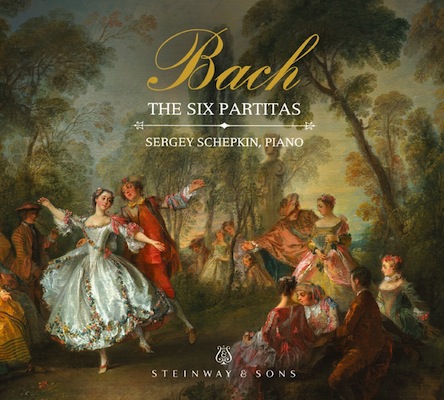
Sergey Schepkin: J. S. Bach: The Six Partitas, BWV 825-830
2-CD set Steinway & Sons 30069
(No high-resolution download available at present)
Recorded September 2014 and September 2015, Jordan Hall, New England Conservatory, Boston, Massachusetts; Sergey Schepkin, producer; Patrick Keating, engineer.
Even if your only exposure to Bach’s great keyboard works played on the modern piano is one or another of Glenn Gould’s recordings of the Goldberg Variations (there are three, you know), you really should consider buying this new set of the Partitas on Steinway & Sons’ CD label. Don’t be scared off by the technical term “Partita.” All that means is that these are multi-movement works made up of parts; specifically, sections that usually were named after dances. Bach’s contemporaries would have understood the dance names such as “Sarabande” as giving an idea as to the tempo and feeling of each segment. The liner notes make the important point that this is not music to dance to; it is music for its own sake, about the idea or the ideal of dancing.
Sergey Schepkin’s playing is technically as good as anyone else’s out there, and his interpretations are a moveable feast—by turns fleet, witty, and playful; or, delicate, subtle, and pensive (or even serious or solemn). This music can mind its own business in the background at Campari time, but it is also worth your undivided attention late at night.
Backstory, details, and elaboration after the jump; and with generous sound samples, of course. Continue Reading →
Catalina Vicens: “Parthenia,” Keyboard Music from 1613
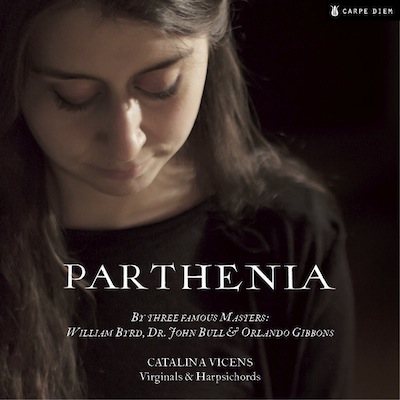
Catalina Vicens: Parthenia
Harpsichord & Virginal Music From 1613
CD Carpe Diem 16298
24/96 + 24/192 FLAC downloads from Carpe Diem
Recorded January 22-26, 2013, Schloss Bad Krozingen, Germany; Jonas Niederstadt, producer.
What a wonderful project and what a wonderful recording! Catalina Vicens is an immensely talented and very hard-working Curtis Institute graduate, originally from Chile. She won an international early-keyboard competition hosted by the Bad Krozingen Castle. As a result, the Cultural Office of the City of Bad Krozingen and the the Fritz Neumeyer Historical Keyboards Collection made possible this, her début recording.
This is one of the most impressive and engaging keyboard recordings I have heard in years. The recorded sound is pristine and very dynamic and satisfyingly reverberant—even better, the recording was made to audiophile standards using DPA 4006 microphones, and there are 24/96 and 24/192 FLAC downloads available. Just go for it!
More, and generous sound bytes, after the jump. Continue Reading →
We So Rarely Hear About the Good That Is Done in the World
It almost goes without saying that the mainstream media long ago fell into a sensationalist rubric of, “If it bleeds, it leads.” So a Jeremiad from me about that would be almost pointless.
Please click for the continuation. Continue Reading →
Yevgeny Sudbin: 18 Sonatas by Domenico Scarlatti (1685–1757)
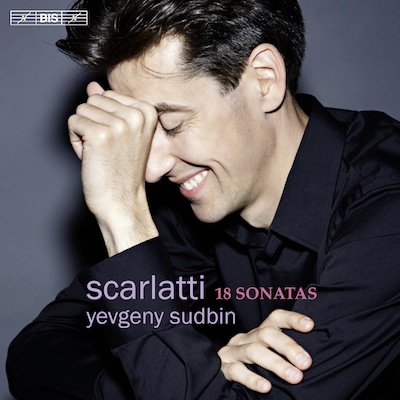
Yevgeny Sudbin: 18 Sonatas by Domenico Scarlatti (1685–1757)
Sonatas K 417 in D minor; K 208 in A major; K 159 in C major; K 56 in C minor; K 213 in D minor; K 125 in G major; K 373 in G minor; K 119 in D major; K 69 in F minor; K 425 in G major; K 29 in D major; K 99 in C minor; K 12 in G minor; K 479 in D major; K 9 in D minor; K 318 in F sharp major; K 141 in D minor; and K 32 in D minor.
AUTOGRAPHED Compatible stereo + MCH SACD/CD BIS 2138; CDQ or 24/96 download, Classics Online.
Domenico Scarlatti wrote these sonatas for his patroness Maria Magdalena Barbara, the Infanta of Portugal.
Mitzi “married up,” later becoming the Queen of Spain. (No, her nickname was not “Mitzi;” so, don’t bother writing in. But please, do find a different reason to write in!) Maria Magdalena Barbara had a nearly-insatiable appetite for… keyboard sonatas. Scarlatti wrote more than 500 of them. Furthermore, Scarlatti wrote almost all of those sonatas for the harpsichord.
Therefore, it is an historical irony, one reflected upon by Yevgeny Sudbin in his truly excellent liner notes, that today, these works are most often associated with Russian pianists; Vladimir Horowitz being the prime example. Sudbin claims that Russian musical education uses Scarlatti’s keyboard music more than does any other country’s pedagogy; and, that well may be true. Ten years ago, Sudbin made his début (all-Scarlatti), recording for Sweden’s label BIS; it received rapturous reviews. Volume Two, so to speak, is his tenth-anniversary celebration.
The bottom line is, this recording is an absolute “must-buy” for piano lovers. (Historically-Informed Performance people, perhaps not so much.) Sound samples and more, after the jump. Continue Reading →
Marita Sølberg: Opera Arias
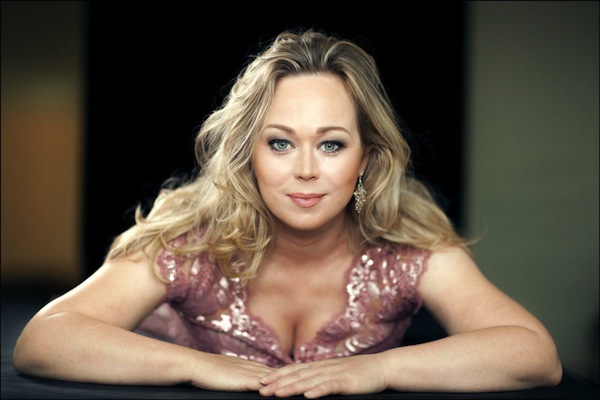
(Courtesy www.maritasolberg.com; photo credit Felix Broede.)
Marita Sølberg: Opera Arias
Opera arias by Catalani, Mozart, Gounod, Bizet, Leoncavallo, Puccini, Bellini, Rachmaninoff, Dvořák, Verdi, and R. Strauss.
Norwegian National Opera Orchestra
John Fiore, conductor
CD Simax Classics PSC1336
Say “Hello” to Marita Sølberg!
Marita Sølberg’s name was unknown to me when I stumbled upon her upcoming new release (which came out last Friday) on Naxos’ (Simax’ US distributor’s) ultra-top-secret, password-protected publicity website, which is, I am told, hosted on a server in the kitchen of an excellent barbecue place down near Chattanooga. The track list contained both old favorites and a couple of unknown arias, so I dutifully hit “Download.”
The program starts with a very well-played (Norwegian National Opera Orchestra; John Fiore, conductor), well-recorded orchestral introduction to the famous Puccini-esque aria “Ebben; Ne andro lontana” from Catalani’s obscure-except-for-one-aria opera La Wally. So far, so good.
Then, Miss Sølberg started to sing, pensively and almost languidly. Oh dear me. This one does not go into the “Discard” pile… . (More than half of the new recordings I listen to, I pass over in silence.)
Generous sound clips and more, after the jump. Clickez!
David Leisner & Zuill Bailey: Arpeggione
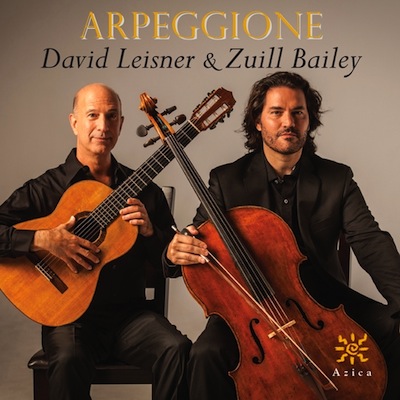
David Leisner & Zuill Bailey: Arpeggione
Music for classical guitar and cello
CD Azica ACD-71306
24/96 Download from Pro Studio Masters
This CD is not just for classical listeners—anyone who loves beauty and wants more of it in his or her life should buy this recording. This cleverly-constructed disc is arranged like an old-fashioned recital program.
Serious music at the start (if you want to call Schubert’s contagiously lighthearted Arpeggione sonata “serious,”); followed by a guitar/cello treatment of Falla’s Spanish Popular Songs; then a wee homeopathic dose of accessible new music; and then all four shoes drop in a succession of surefire crowd-pleasers: “Dance of the Blessed Spirits,” “The Swan,” Bachianas Brasileiras No. 5 (“Aria”), and finally Paganini’s Moses variations.
The recorded sound is absolutely stunning, completely worthy of the best systems at the next audio expo. Hint, hint. (Recorded by Bruce Egre at Cleveland State University’s Waetjen Auditorium.)
Words about the performers, followed by some generous sound bites, await you after the jump. Clickez-vous, s-v-p!
Van Morrison: “Moondance” Deluxe Edition
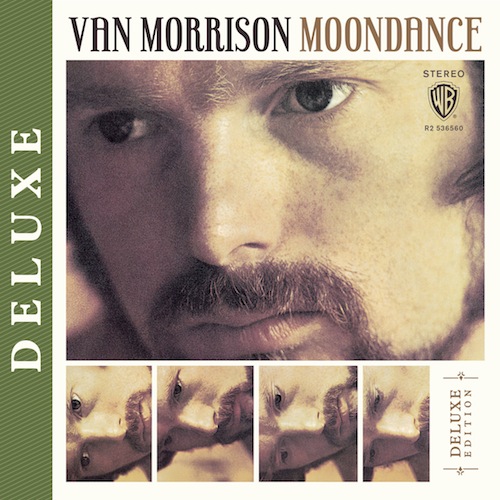
Van Morrison: Moondance Deluxe Edition
Recorded August to December 1969, released January 1970; remastered 2013.
HD Tracks download HX603497907663
8-CD/1 Blu-ray boxed set, Warner Bros. Records R2 53656
Van Morrison, vocals, guitar, rhythm guitar, tambourine, harmonica, producer; John Klingberg, bass; Gary Mallaber, drums, vibraphone; Guy Masson, conga; John Platania, guitar, rhythm guitar; Jef Labes, organ, piano, clavinet; Jack Schroer, alto and soprano saxophones; Collin Tilton, flute, tenor saxophone; Judy Clay, Emily Houston, Jackie Verdell, backing vocals (tracks 3 and 8).
Moondance was George Ivan “Van” Morrison’s third studio album. His previous ones having been the somewhat inscrutable Astral Weeks and the earlier, somewhat slapdash Blowin’ Your Mind. The latter was assembled without Morrison’s cooperation (or knowledge) from takes originally intended to be released as 45-rpm singles.
Blowin’ Your Mind was an effort to capitalize upon the success of Morrison’s Irish rock band “Them.” Them’s memorable one hit of wonder was “Gloria.” An indication of Them’s brief but major eminence was that when them had a residency at Los Angeles’ Whisky a Go Go in 1966, their opening act was: The Doors. (Sorry, I could not resist.)
Morrison Jim was hugely impressed by Morrison Van’s poetry and by his stage presence. On the last night of the gig, the two bands jammed on “Gloria.” Not shabby.


